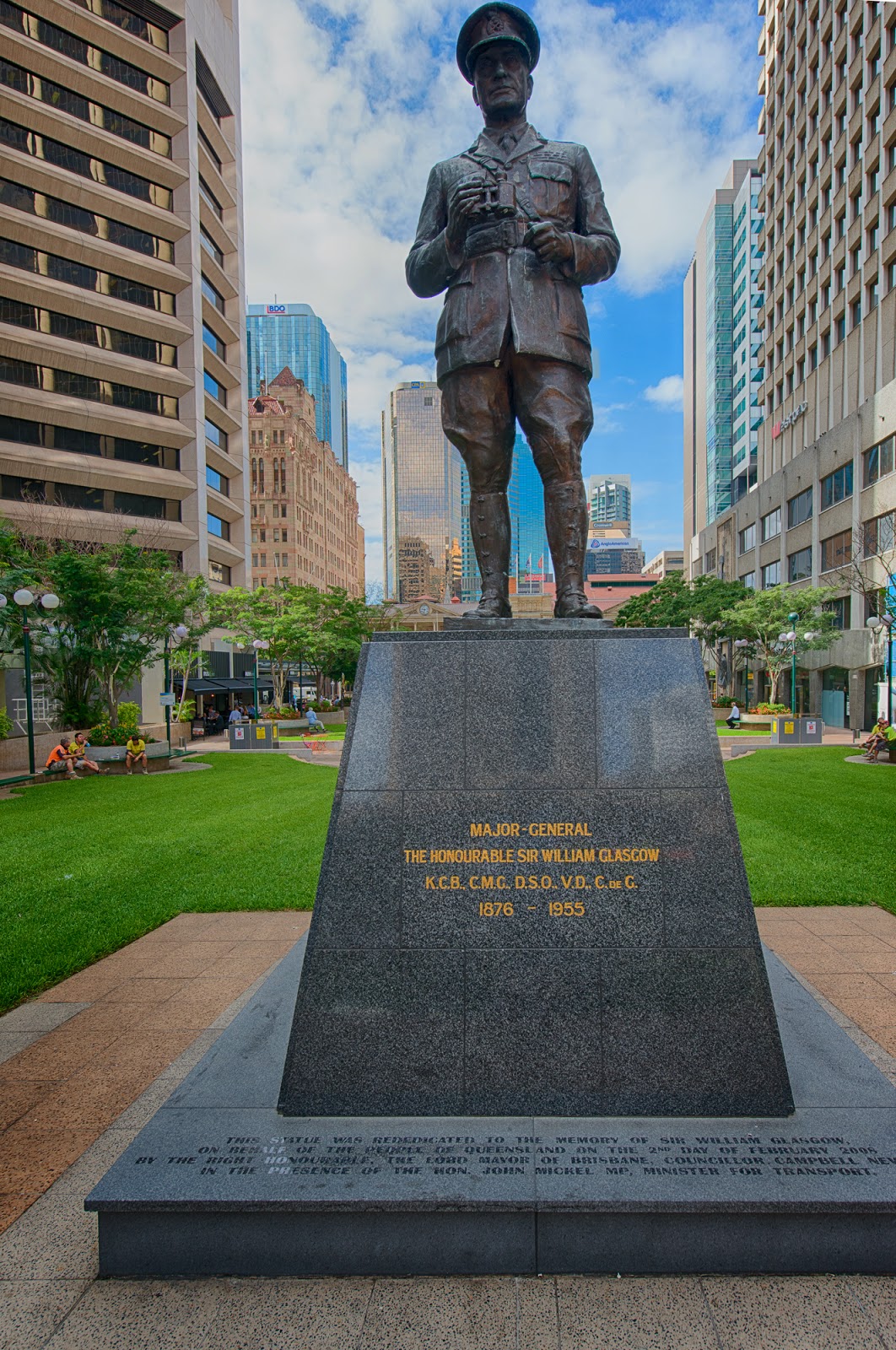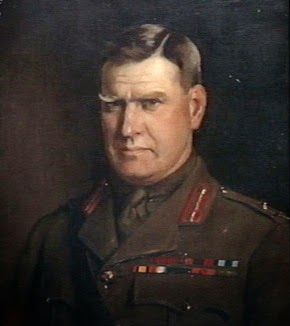Just recently one of my favourite blogs,ART and ARCHITECTURE, mainly, posted a piece on scholar, engineer, decorated soldier and famous Australian Sir John Monash. It got me thinking about one of Queensland's famous soldiers and a Monash contemporary, Sir TW (William) Glasgow. Glasgow is commemorated in this Daphne Mayo sculpture that stands in Post Office Square overlooking Anzac Square in Brisbane. This statue was her last major work, but unfortunately it has been reported that she was not overly happy with the finished product.
(Photo: © 2014 the foto fanatic)
The Glasgow statue was completed in 1964 and has been moved around a bit - first it was placed in the police reserve on the corner of Ann and Roma Sts at a dedication on Anzac Day 1966. In 1968 it was shifted to a spot near the Roma St tunnel (below).
(Photo: BCC-B54-28702)
Finally in 2008 it was moved to its present spot in Post Office Square facing Anzac Square. This placing is eminently suitable as it overlooks the Anzac Day marches - Glasgow led the Brisbane march for twenty years. In the following photograph you can see the old general standing behind the crowd observing an Anzac Day march past.
Glasgow the man was a soldier, as well as a grazier, politician and a diplomat. As a teenager he joined the Queensland Mounted Infantry and later volunteered for the Boer War, participating in some of the major actions there. He was awarded the Distinguished Service Order in 1901 as a 24 year-old lieutenant.
By the time WWI erupted Glasgow, by then married and the owner of a cattle property in Central Queensland, had been promoted to Major in the Light Horse Regiment that he had formed in the town of Gympie. He left for Egypt in September 1914 as a Major in the 2nd Light Horse, training there until landing at Gallipoli on 12 May 1915. He was involved in brutal action that saw heavy losses at Anzac Cove in August 1915. He participated in an attack on Dead Man's Ridge where 154 of the 200 men he led were killed or injured. Glasgow was the only officer who had not been hit, and he ordered a withdrawal. Glasgow himself was amongst the last to retreat, and he carried a wounded digger back to safety. This resulted in Glasgow being promoted to Lieutenant Colonel and command of his regiment on the following day.
In March 1916 Glasgow was sent to the Western Front as commander of the 13th Infantry Brigade. He subsequently saw action at hell-holes like Messines, Villers-Bretonneux, Flanders, Amiens and the Hindenburg Line. In April 1918 Glasgow and his 13th Brigade excelled themselves at the Villers-Bretonneux second battle, wresting back control of the town from the Germans in a daring night-time raid orchestrated by Glasgow, who by then had risen to the rank of Briadier-General. Monash described the Villers-Bretonneux victory as the turning point of the war, and said this of Glasgow:
"Of strong though not heavy build and of energetic demeanour, Glasgow succeeded not so much by exceptional mental gifts or by tactical skill of any high order as by his personal driving force and determination, which impressed themselves upon all of his subordinates. He always got where he wanted to get - was consistently loyal to the Australian ideal, and intensely proud of the Australian soldier."
(Photo: © Australian War Memorial via wikipedia)
There is no doubting that Glasgow was a tough commander. He was a disciplinarian who was especially hard on deserters, whom he thought deserved the death penalty. But his own heroism and sense of duty was unquestioned - he was Mentioned in Dispatches 9 times; the French government awarded him the Légion d'Honneur and the Croix de Guerre; he also won a Belgian Croix de Guerre.The successful campaigns that he led saw him awarded a series of Australian/British honours - CMG, CB; and finally KCB (Knight Commander of the Bath) that was published in the 1919 New Years' Honours List.
Later in that year, after his return to Australia, he ran for and was elected to the Senate. He become a minister in 1926, holding various portfolios until he lost his seat in 1936. In 1939 he became Australia's first High Commissioner to Canada. Here he is, left of picture, welcoming Australia's prime minister Robert Menzies (centre) to Canada in the company of Canada's prime minister, William Mackenzie King (right of picture).
(Photo: Australian War Memorial; P00048.144)
During WWII Glasgow was heavily involved with allies Canada and the United States, and as Australia's representative attended the 1944 Quebec Conferenceswith British Prime Minister Sir Winston Churchill, US President Theodore Roosevelt and Canadian Prime Minister William Mackenzie King. He was also had oversight of the Empire Air Training Scheme that turned out Australian, New Zealand and Canadian pilots for the European theatre. Glasgow became quite well-known and popular in Canada, and there was even a push from certain quarters to name him as the first non-British Governor-General of Canada as a sort of half-way step towards appointing a Canadian to that post.
In 1945 Sir William Glasgow returned to Australia where he resumed his pastoral interests and served on several boards. He died in Brisbane on 4 July 1955, and was given a state funeral after a service at St Andrew's Presbyterian Church.
Lest We Forget.
Click here for a Google Map.
tff
(Photo: © 2014 the foto fanatic)
The Glasgow statue was completed in 1964 and has been moved around a bit - first it was placed in the police reserve on the corner of Ann and Roma Sts at a dedication on Anzac Day 1966. In 1968 it was shifted to a spot near the Roma St tunnel (below).
(Photo: BCC-B54-28702)
Finally in 2008 it was moved to its present spot in Post Office Square facing Anzac Square. This placing is eminently suitable as it overlooks the Anzac Day marches - Glasgow led the Brisbane march for twenty years. In the following photograph you can see the old general standing behind the crowd observing an Anzac Day march past.
(Photo: www.carlajayne.com)
By the time WWI erupted Glasgow, by then married and the owner of a cattle property in Central Queensland, had been promoted to Major in the Light Horse Regiment that he had formed in the town of Gympie. He left for Egypt in September 1914 as a Major in the 2nd Light Horse, training there until landing at Gallipoli on 12 May 1915. He was involved in brutal action that saw heavy losses at Anzac Cove in August 1915. He participated in an attack on Dead Man's Ridge where 154 of the 200 men he led were killed or injured. Glasgow was the only officer who had not been hit, and he ordered a withdrawal. Glasgow himself was amongst the last to retreat, and he carried a wounded digger back to safety. This resulted in Glasgow being promoted to Lieutenant Colonel and command of his regiment on the following day.
In March 1916 Glasgow was sent to the Western Front as commander of the 13th Infantry Brigade. He subsequently saw action at hell-holes like Messines, Villers-Bretonneux, Flanders, Amiens and the Hindenburg Line. In April 1918 Glasgow and his 13th Brigade excelled themselves at the Villers-Bretonneux second battle, wresting back control of the town from the Germans in a daring night-time raid orchestrated by Glasgow, who by then had risen to the rank of Briadier-General. Monash described the Villers-Bretonneux victory as the turning point of the war, and said this of Glasgow:
"Of strong though not heavy build and of energetic demeanour, Glasgow succeeded not so much by exceptional mental gifts or by tactical skill of any high order as by his personal driving force and determination, which impressed themselves upon all of his subordinates. He always got where he wanted to get - was consistently loyal to the Australian ideal, and intensely proud of the Australian soldier."
(Photo: © Australian War Memorial via wikipedia)
There is no doubting that Glasgow was a tough commander. He was a disciplinarian who was especially hard on deserters, whom he thought deserved the death penalty. But his own heroism and sense of duty was unquestioned - he was Mentioned in Dispatches 9 times; the French government awarded him the Légion d'Honneur and the Croix de Guerre; he also won a Belgian Croix de Guerre.The successful campaigns that he led saw him awarded a series of Australian/British honours - CMG, CB; and finally KCB (Knight Commander of the Bath) that was published in the 1919 New Years' Honours List.
Later in that year, after his return to Australia, he ran for and was elected to the Senate. He become a minister in 1926, holding various portfolios until he lost his seat in 1936. In 1939 he became Australia's first High Commissioner to Canada. Here he is, left of picture, welcoming Australia's prime minister Robert Menzies (centre) to Canada in the company of Canada's prime minister, William Mackenzie King (right of picture).
(Photo: Australian War Memorial; P00048.144)
During WWII Glasgow was heavily involved with allies Canada and the United States, and as Australia's representative attended the 1944 Quebec Conferenceswith British Prime Minister Sir Winston Churchill, US President Theodore Roosevelt and Canadian Prime Minister William Mackenzie King. He was also had oversight of the Empire Air Training Scheme that turned out Australian, New Zealand and Canadian pilots for the European theatre. Glasgow became quite well-known and popular in Canada, and there was even a push from certain quarters to name him as the first non-British Governor-General of Canada as a sort of half-way step towards appointing a Canadian to that post.
In 1945 Sir William Glasgow returned to Australia where he resumed his pastoral interests and served on several boards. He died in Brisbane on 4 July 1955, and was given a state funeral after a service at St Andrew's Presbyterian Church.
Lest We Forget.
Click here for a Google Map.
tff


